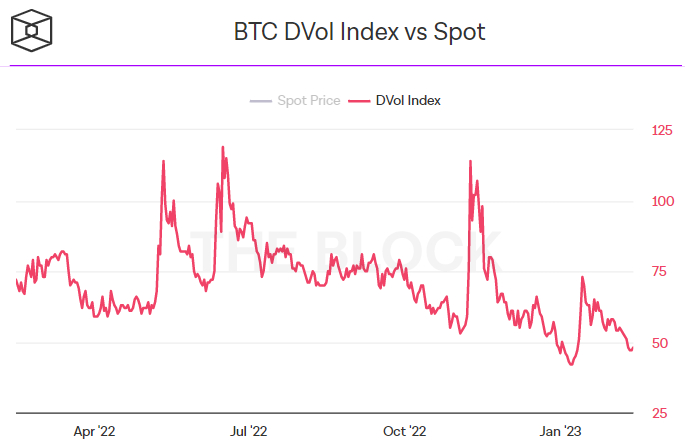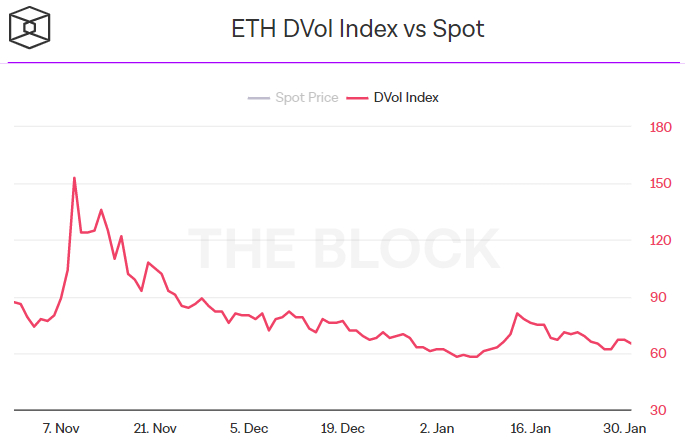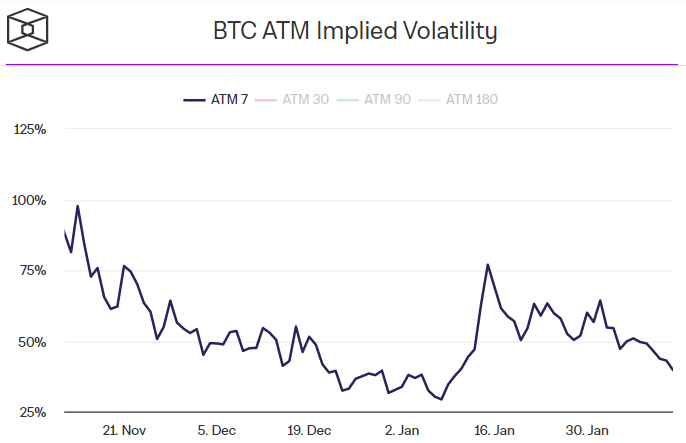Despite the recent pullback in cryptocurrency markets from multi-month highs hit earlier this month, options markets suggest that traders still have relatively subdued volatility expectations. Deribit’s Bitcoin and Ethereum Volatility Indices both remain close to record lows, according to data provided by The Block going back one year.
The recent pullback in crypto prices that has seen Bitcoin fall back into the mid-$21,000s from earlier annual highs above $24,000 and Ethereum fall under $1,500 from earlier annual highs above $1,700 has been caused by a combination of 1) worries about a more restrictive US interest rate outlook in wake of recent hawkish Fed communications and stronger than expected US data and 2) concerns about a US regulatory crackdown on large US-based crypto firms.

Deribit’s Bitcoin Volatility Index was at 48 on Monday, not far above the record lows it printed last month at 42 and well below mid-January highs of 73. Deribit’s Ethereum Volatility Index, meanwhile, was last at 62, just above its early January record lows around 58 and down sharply from recent mid-January highs above 80. Deribit is the dominant cryptocurrency derivatives exchange, accounting for around 95% of open interest across all Bitcoin and Ethereum derivative markets.

Short-term Volatility Expectations Also Subdued
Despite looming US Consumer Price Index and Retail Sales data this week that could simultaneously inform expectations for the Fed’s tightening outlook and the outlook for a potential US recession later this year, Bitcoin’s 7-day Implied Volatility according to At-The-Money (ATM) options markets fell to 39.68% on Monday, its lowest in more than a month.

That’s despite warnings from macro strategists that this week’s upcoming data could really shake things up for crypto, with an upside inflation surprise touted as a potential catalyst to send Bitcoin back towards $20,000.

Investors Underestimating Price Volatility Risks?
With Deribit’s Bitcoin and Ethereum Volatility indices and Bitcoin’s 7-day ATM Implied Volatility all at subdued levels, the interpretation is that investors aren’t positioning for big moves in the short or medium term. But this relaxed attitude to crypto price volatility risks may be misplaced, with many strategists warning that the choppy bear market conditions of 2022 may return.
Indeed, Bloomberg senior macro strategist Mike McGlone on Monday issued a reminder to crypto traders – “Don’t fight the Fed”. Monetary tightening from the US Federal Reserve “was the dominant headwind for (crypto) markets in 2022 and remains so in Q1 (2023),” McGlone continued. The Fed raised interest rates aggressively from close to zero to above 4.0% in 2022 and looks intent on lifting them above 5.0% in the first half of 2023, according to the latest commentary from the bank’s policymakers.
Commenting on the Bitcoin market, “the more tactically orientated are likely to focus on responsive selling, and it may be a while before the buy-and-hold types gain the upper hand”. McGlone’s comments chime with a popular sentiment held by many analysts at the moment – Crypto (and US stock) markets appear to be ignoring macro risks. Many analysts go a step further than McGlone and forecast outright that the crypto pullback that began earlier this month has further to run.
Despite the recent pullback in cryptocurrency markets from multi-month highs hit earlier this month, options markets suggest that traders still have relatively subdued volatility expectations. Deribit’s Bitcoin and Ethereum Volatility Indices both remain close to record lows, according to data provided by The Block going back one year.
The recent pullback in crypto prices that has seen Bitcoin fall back into the mid-$21,000s from earlier annual highs above $24,000 and Ethereum fall under $1,500 from earlier annual highs above $1,700 has been caused by a combination of 1) worries about a more restrictive US interest rate outlook in wake of recent hawkish Fed communications and stronger than expected US data and 2) concerns about a US regulatory crackdown on large US-based crypto firms.

Deribit’s Bitcoin Volatility Index was at 48 on Monday, not far above the record lows it printed last month at 42 and well below mid-January highs of 73. Deribit’s Ethereum Volatility Index, meanwhile, was last at 62, just above its early January record lows around 58 and down sharply from recent mid-January highs above 80. Deribit is the dominant cryptocurrency derivatives exchange, accounting for around 95% of open interest across all Bitcoin and Ethereum derivative markets.

Short-term Volatility Expectations Also Subdued
Despite looming US Consumer Price Index and Retail Sales data this week that could simultaneously inform expectations for the Fed’s tightening outlook and the outlook for a potential US recession later this year, Bitcoin’s 7-day Implied Volatility according to At-The-Money (ATM) options markets fell to 39.68% on Monday, its lowest in more than a month.

That’s despite warnings from macro strategists that this week’s upcoming data could really shake things up for crypto, with an upside inflation surprise touted as a potential catalyst to send Bitcoin back towards $20,000.

Investors Underestimating Price Volatility Risks?
With Deribit’s Bitcoin and Ethereum Volatility indices and Bitcoin’s 7-day ATM Implied Volatility all at subdued levels, the interpretation is that investors aren’t positioning for big moves in the short or medium term. But this relaxed attitude to crypto price volatility risks may be misplaced, with many strategists warning that the choppy bear market conditions of 2022 may return.
Indeed, Bloomberg senior macro strategist Mike McGlone on Monday issued a reminder to crypto traders – “Don’t fight the Fed”. Monetary tightening from the US Federal Reserve “was the dominant headwind for (crypto) markets in 2022 and remains so in Q1 (2023),” McGlone continued. The Fed raised interest rates aggressively from close to zero to above 4.0% in 2022 and looks intent on lifting them above 5.0% in the first half of 2023, according to the latest commentary from the bank’s policymakers.
Commenting on the Bitcoin market, “the more tactically orientated are likely to focus on responsive selling, and it may be a while before the buy-and-hold types gain the upper hand”. McGlone’s comments chime with a popular sentiment held by many analysts at the moment – Crypto (and US stock) markets appear to be ignoring macro risks. Many analysts go a step further than McGlone and forecast outright that the crypto pullback that began earlier this month has further to run.